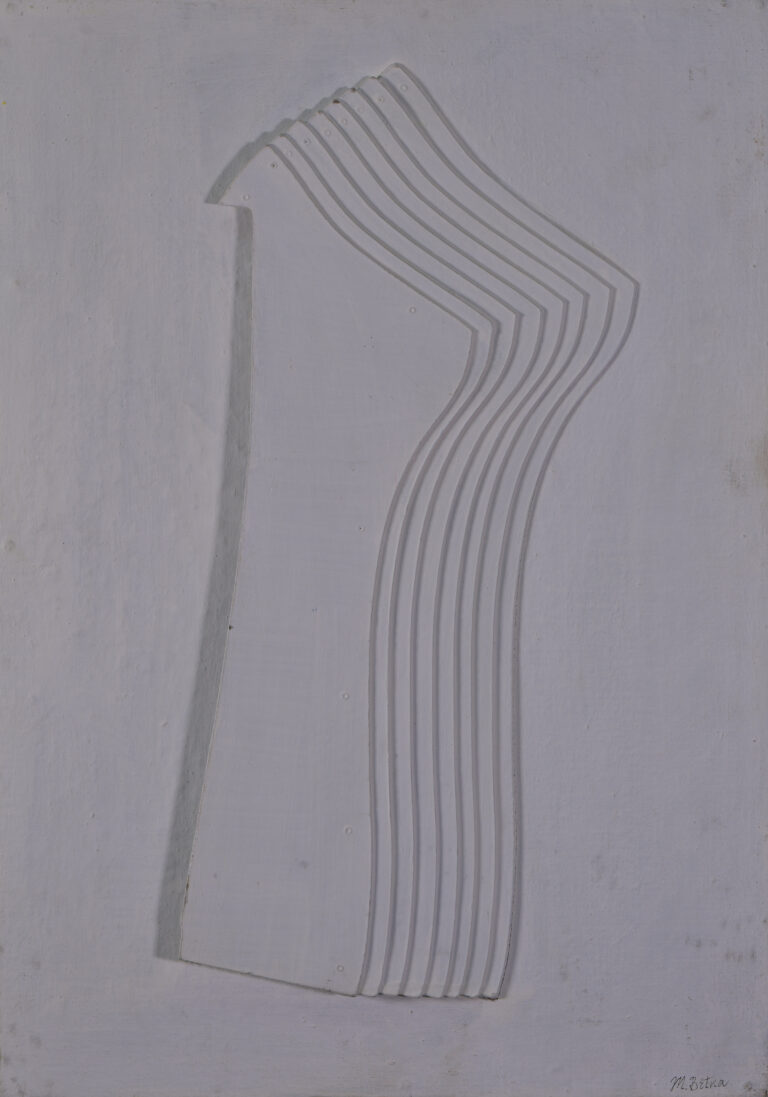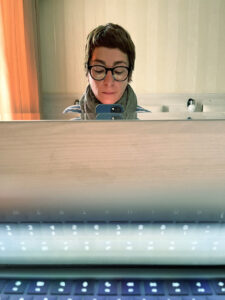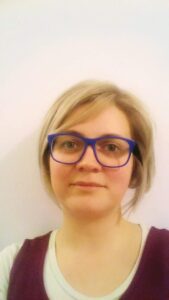Mira Brtka

Mira Brtka (5th October 1930, Novi Banovci, Kingdom of Yugoslavia – 18th December 2014, Belgrade, Serbia) graduated in film and theatre direction in 1958 at the Academy for Theatre and Film Art in Belgrade in the class of professors Vjekoslav Afrić, Josip Kulundžić and Slavko Vorkapić. She also graduated from the Academy of Fine Arts in Roma in 1963, department of painting, in the class of professors Franco Gentilini and Mino Maccari. She was a member of the international art group Illumination to the end of the 1960s as well as the activist-art movement Bureau for Preventive Imagination. She was a complex personality as she, alongside painting, did sculpture, fashion, costume design, theatre and film direction, animated films, etc. She presented her art at numerous solo and collective exhibitions. Her first solo exhibition was held in 1964 in Artflex gallery in Rome, Italy. The first retrospective exhibition of Mira Brtka’s art was held in 2012 in the Museum of Contemporary Art of Vojvodina in Novi Sad and it was entitled “Mira Brtka: Unstable Balances (1962-2012)”. The second retrospective entitled “Reflections” was held in 2021 in The City Museum of Belgrade in Belgrade in collaboration with the Mira Brtka Foundation.
Mira Brtka’s123 artistic oeuvre is very broad and complex4567. She started painting after her studies in Rome. Her paintings from this period are made in the style of Art Informel that was in vogue at the time she started painting. She was exploring color and light in her creative phase when she was a member of the art group Illumination (from 1967) that was established by Japanese artist Nobuya Abe in Rome. That period is considered as the key one for her further artistic development, since it was then when she secured foundations for her future paintings and sculptures. She starts exhibiting in Yugoslavia in 1970, first in the pavilion of the Association of Fine Artists of Bosnia and Herzegovina in Sarajevo, and afterwards in 1971 in the Gallery of Contemporary Visual Art in Novi Sad and the Salon of the museum of Contemporary Art in Belgrade. Paintings from this period are characterized by intense colors, symmetry, relatively organic forms as it belonged to the so-called painting of the rough edges. Mira Brtka’s oeuvre also comprises white monochromatic paintings of geometrical shapes with relief surfaces which displayed a subtle shadow play depending on the position of the spectator and of light sources. At one time she was working on collages and reliefs of vibrant colors, as well as paintings made of hand woven materials that she designed and that were made by Slovak women practicing traditional embroidery techniques.
She also made animated films and in 1965 she was involved with Giulio Gianini and Emanuele Luzzati in the making of the film The Thieving Magpie (La gazza ladra) that was nominated for the Oscar. She also participated in special effects making in collaboration with Carlo Rambaldi on films such as Barbarella, King Kong and E.T. the Extra-Terrestrial. She made with Nikola Majdak in 1963 the animated film Soloist which is considered to be the first film of the Belgrade school of animated film8.
The Bureau for Preventive Imagination was established in 1973 in Rome and it had branches in France (Nantes), the USA (New York) and Brazil (Rio de Janeiro). Her activities within this activist-artist movement resulted in her establishing the Bureau for Balkanization of Art in Stara Pazova in Serbia. During this period of Mira Brtka’s artistic development she made The Red Suitcase, an artwork that included artifacts that she collected during her activity in the Bureau for Preventive Imagination and it was exhibited at the Venice biennial.
She began sculpting in the late 1990s, and it was often with found materials and objects that she further processed. Compositions are often kinetic, and the forms span from abstraction, transparent lines in space, to figurative and associative shapes. Materials used are various, often industrial such as metal, Lucite or Plexiglas, etc.
Her artworks are a part of numerous international public and private collections.
Mirjana Dragosavljević (2022).
1Illustration: Mira Brtka, “No title”, combined technique, courtesy of the Gallery of Matica Srpska.2Reference: https://www.youtube.com/watch?v=mVXrWi6W-hQ.
3Reference: https://www.mirabrtka.rs.
4Illustration: Mira Brtka, “Construction I”, oil painting, 1965, courtesy of the Museum of Contemporary Art Belgrade.
5Illustration: Mira Brtka, “Painting IV”, acrylic painting, 2004, courtesy of the Gallery of Matica Srpska.
6Illustration: Mira Brtka, “Blue-black painting”, acrylic painting, 2004, courtesy of the Gallery of Matica Srpska.
7Illustration: Mira Brtka, “Leafed out sculpture”, sculpture, 2000, courtesy of the Gallery of Matica Srpska.
8Reference: https://www.youtube.com/watch?v=3cvaRL2jBmE.
Mira Brtka (5. oktobar 1930, Novi Banovci, Kraljevina Jugoslavija – 18. decembar 2014, Beograd, Srbija) je 1958. godine završila studije režije na Akademiji za pozorišnu i filmsku umetnost u Beogradu, u klasi profesora Vjekoslava Afrića, Josipa Kulundžića i Slavka Vorkapića. Diplimirala je na Akademiji lepih umetnosti u Rimu 1963. godine, smer slikarstvo u klasi profesora Franka Đentilinija i Mina Makarija. Bila je članica međunarodne umetničke grupe „Illumination“ do kraja šezdesetih godina prošlog veka, kao i aktivističko-umetničkog pokreta „Biro za preventivnu imaginaciju“. Bila je svestrana ličnost, pored slikarstva, bavila se skulpturom, modom, kostimografijom, pozorišnom i filmskom režijom, animiranim filmom, itd. Izlagala je na brojnim samostalnim i grupnim izložbama. Prvu samostalnu izložbu imala je 1964. u Artflex galeriji u Rimu u Italiji. Prva retrospektivna izložba Mire Brtke održana je 2012. godine u Muzeju savremene umetnosti Vojvodine u Novom Sadu pod nazivom „Mira Brtka: Nestabilne ravnoteže (1962-2012)”. Druga retrospektivna izložba „Refleksije“ održana je 2021. godine u Muzeju grada Beograda u Beogradu, u saradnji sa fondacijom Mira Brtka.
Umetnički opus Mire Brtke123 veoma je bogat i kompleksan4567. Slikarstvom počinje da se bavi nakon pomenutih studija slikarstva u Rimu. Slike iz ovog početnog perioda Mira Brtka izvodi u duhu poznog enformela, koji je bio aktuelan u vreme kada je počinjala da se bavi slikarstvom. Boju i svetlost počinje da istražuje u okviru svoje stvaralačke faze kada je bila članica grupe „Illumination“ (od 1967. godine), koju je osnovao japanski umetnik Nobuya Abe u Rimu. Taj period se smatra ključnim za dalji umetnički razvoj Mire Brtke, jer je tada utvrdila temelje koji će uvek biti prisutni u njenom slikarstvu i skulpturi. Počinje da izlaže 1970. godine u Jugoslaviji, prvo izložbom u paviljonu Udruženja likovnih umetnika Bosne i Hercegovine (ULUBIH) u Sarajevu, potom 1971. izložbama u Galeriji savremene vizuelne umetnosti u Novom Sadu i u Salonu Muzeja savremene umetnosti u Beogradu. Slike iz ovog perioda odlikuju intenzivne boje, simetrija, relativno organski oblici, u pitanju je tzv. slikarstvo grubih ivica. Opus Mire Brtke sadrži i bele monohrome, slike geometrijskih reljefnih površina na kojima, usled promene položaja posmatrača i u zavisnosti od toga kako je svetlost postavljena, može da se zapazi suptilna dinamika senki. U jednom periodu je radila kolaže i reljefe raskošnih boja, kao i slike od ručno vezenog materijala za koji je ona pravila nacrte, a žene koje su se bavile tradicionalnim slovačkim ručnim radom su ih popunjavale vezom.
Bavila se i animiranim filmom, 1965. godine je sa Đuliom Đaninijem i Emanuelom Lucatijem radila na realizaciji filma „Svraka grabljivica“ koji je bio nominovan za Oskara. Učestvovala je i u izradi specijalnih efekata u saradnji sa slikarem Karlom Rambaldijem za igrane filmove „Barbarela“, „King Kong“ i „ET vanzemaljac“. Sa Nikolim Majdakom 1963. godine radi film „Solista“ koji se smatra prvim filmom Beogradske škole crtanog filma8.
Biro za preventivnu imaginaciju je osnovan 1973. godine u Rimu i imao je svoje ogranke u Francuskoj (Nantes), SAD-u (New York) i Brazilu (Rio de Janeiro). Njene aktivnosti u okviru ovog aktivističko-umetničkog pokreta rezultirale su njenim osnivanjem Biroa za balkanizaciju umetnosti u Staroj Pazovi u Srbiji. U okviru tog delovanja Mire Brtke nastaje „Crveni kofer“ koji je sadržao artefakte koje je ona sakupljala za vreme njenog delovanja u okviru Biroa za preventivnu imaginaciju i on je izložen na Bijenalu u Veneciji.
Skulpture počinje da radi tek krajem 1990ih, vrlo često su u pitanju pronađeni materijali i predmeti koje ona dodatno obrađuje. Kompozicije su često kinetičke, forme se kreću od apstrakcije, transparentnih linija u prostoru, do figurativnih i asocijativnih oblika. Materijali su raznovrsni, industrijski – metal, klirit, pleksiglas, itd.
Njena dela nalaze se u mnogobrojnim međunarodnim javnim i privatnim kolekcijama.
Mirjana Dragosavljević (2022).
1Ilustracija: Mira Brtka, „Bez naziva“, kombinovana tehnika, ljubaznošću Galerije Matice Srpske.2Referenca: https://www.youtube.com/watch?v=mVXrWi6W-hQ.
3Referenca: https://www.mirabrtka.rs.
4Ilustracija: Mira Brtka, “Konstrukcija I”, ulje na platnu, 1965, ljubaznošću Muzeja savremene umetnosti u Beogradu.
5Ilustracija: Mira Brtka, “Slika IV”, akril na platnu, 2004, ljubaznošću Galerije Matice Srpske.
6Ilustracija: Mira Brtka, “Plavo-crna slika IV”, akril na platnu, 2004, ljubaznošću Galerije Matice Srpske.
7Ilustracija: Mira Brtka, “Razlistala skulptura”, skulptura, 2000, ljubaznošću Galerije Matice Srpske.
8Referenca: https://www.youtube.com/watch?v=3cvaRL2jBmE.


